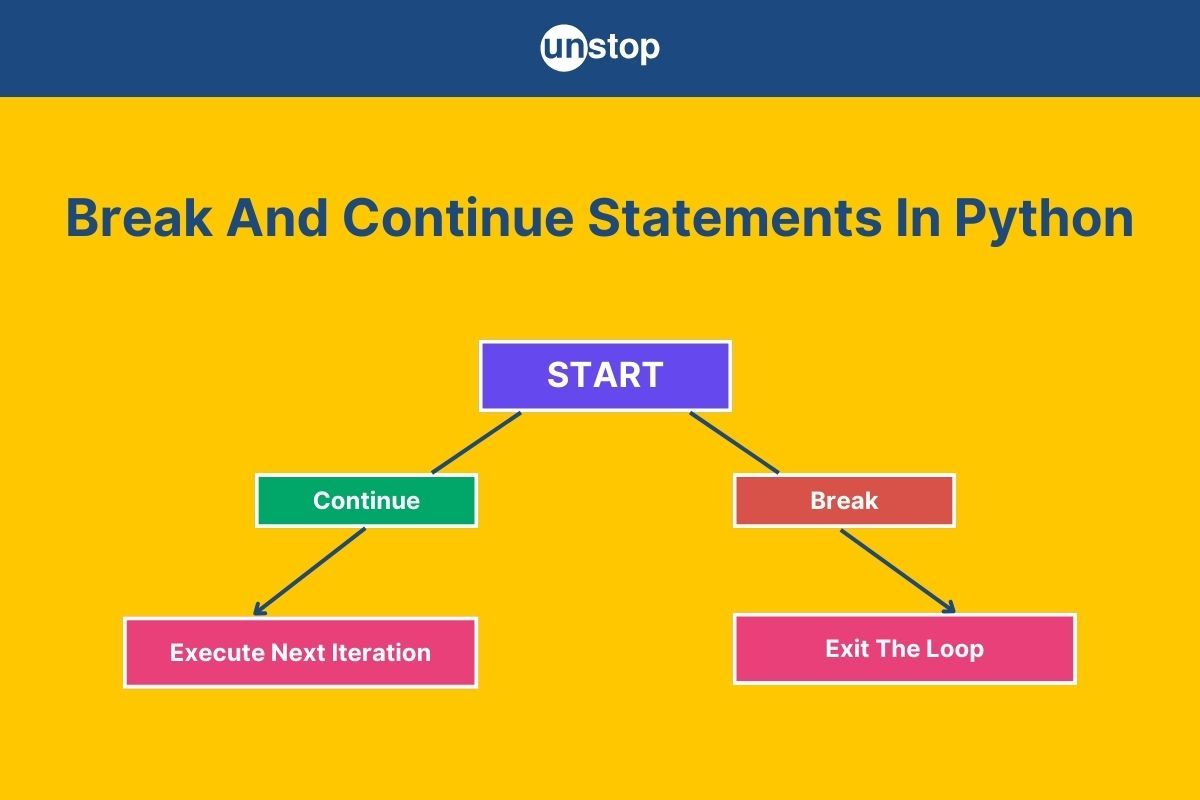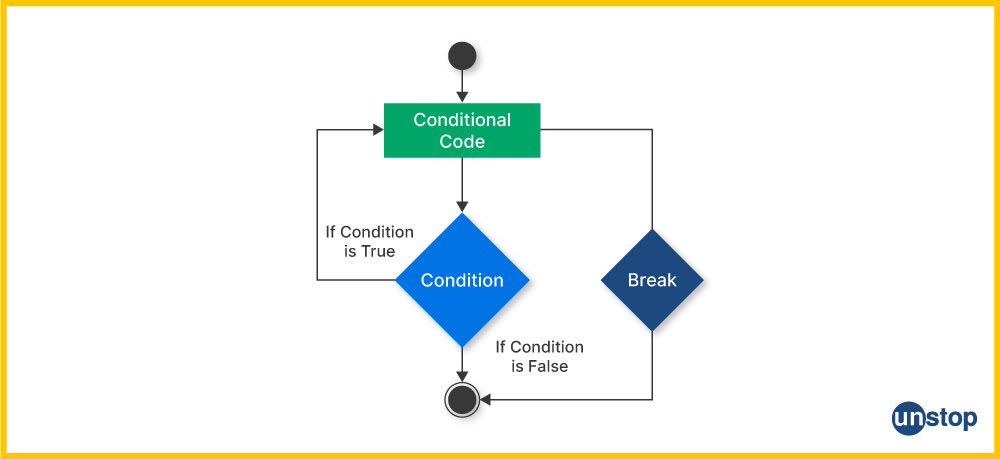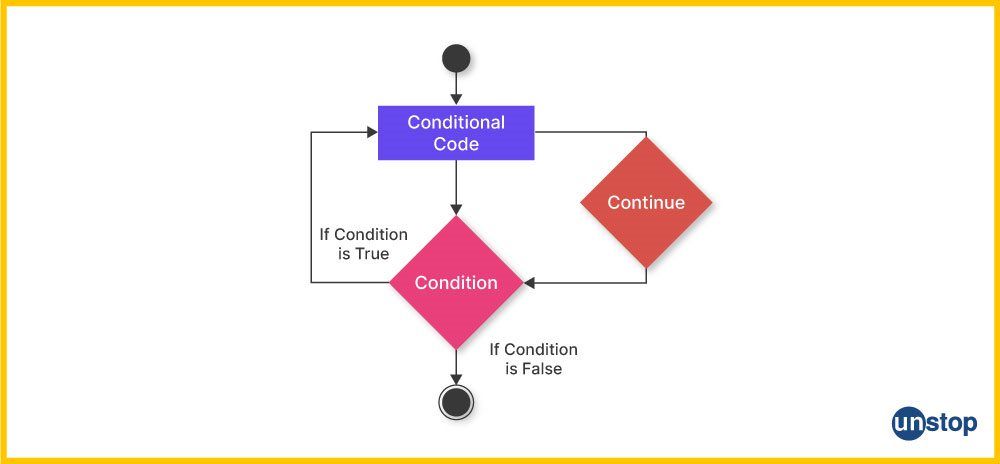- Understanding Python Flow Control
- Break Statement In Python
- Examples Of Break Statements In Python
- Continue Statement In Python
- Examples Of Continue Statements In Python
- Using Break and Continue Statements In A Single Program
- Difference Between Break And Continue Statements In Python
- When To Use Which Statement In Python?
- Conclusion
- Frequently Asked Questions
Break And Continue Statement In Python | Working, Uses & Examples

Ever wondered how to control the flow of your loops in Python? The break and continue statements are your go-to tools. In Python, break and continue statements provide a way to control the flow of loops, allowing us to either exit a loop early or skip specific iterations. These statements enhance the flexibility of loops, giving us fine-grained control over when certain actions should occur.
In this article, we will explore how the break and continue statements in Python work, using practical examples to demonstrate their usage. We'll also discuss scenarios where using these statements can simplify your code and improve efficiency. Let’s dive into how to use them effectively in your Python projects.
Understanding Python Flow Control
Python loop statements allow users to repeat a block of code. The most common types are for and while loops. A for loop iterates over a sequence, like a list. It runs until it has gone through all items. A while loop continues as long as a condition is true. For example, it can keep running until a variable reaches a certain value. Loops are essential for automating repetitive tasks. These looping techniques save time and reduce errors in coding.
Control statements manage the flow of loops. They guide how the program executes specific parts of the code. Without control statements, loops would run endlessly or not at all. This leads to inefficient code. Control statements like break and continue help refine loop behavior. They allow programmers to skip iterations or exit loops based on conditions. This makes code cleaner and easier to understand.
- The break statement stops the loop immediately. For instance, if a certain condition is met, the loop will end.
- The continue statement skips the current iteration and moves to the next one. If a condition is met, it ignores the rest of the code in that iteration but continues looping.
- Using these statements improves efficiency in Python programming. They provide better control over how loops operate.
Break Statement In Python

The break statement in Python is used to exit a loop prematurely, regardless of the loop's condition. When Python encounters a break statement inside a loop (either a for or while loop), it immediately stops the execution of the loop and exits, even if the loop hasn’t finished iterating through all items or conditions.
Working Of Break Statement In Python
- When the break statement is encountered, Python exits the nearest enclosing loop.
- Any remaining iterations of the loop are skipped, and control is transferred to the first statement after the loop.
Syntax Of Break Statement In Python
break
Here, the break keyword instructs Python to exit the loop.
Examples Of Break Statements In Python
In this section, we will understand the working of break statements in Python with the help of code examples:
Example 1: Breaking Out Of A While Loop
Code Example:
i = 1
while i <= 5:
print("Iteration:", i)
if i == 3:
print("Breaking the loop")
break
i += 1
print("Loop exited")
aSA9IDEKCndoaWxlIGkgPD0gNToKICAgIHByaW50KCJJdGVyYXRpb246IiwgaSkKICAgIAogICAgaWYgaSA9PSAzOgogICAgICAgIHByaW50KCJCcmVha2luZyB0aGUgbG9vcCIpCiAgICAgICAgYnJlYWsKICAgICAgICAKICAgIGkgKz0gMQoKcHJpbnQoIkxvb3AgZXhpdGVkIikK
Output:
Iteration: 1
Iteration: 2
Iteration: 3
Breaking the loop
Loop exited
Explanation:
In the above code example-
- We start by initializing variable i to 1.
- Next, we use a while loop that runs as long as i is less than or equal to 5.
- Inside the loop, we print the current iteration value by displaying "Iteration:" followed by the value of i.
- Now we will check if i is equal to 3:
- If this condition is true, we print "Breaking the loop" and exit the loop using the break statement.
- If the value of i is not 3, we increment it by 1 with i += 1.
- Once the loop exits, we print "Loop exited" to indicate that the loop has finished running.
Example 2: Breaking Out Of A For Loop
Code Example:
for letter in "Python":
if letter == "h":
print("Encountered 'h', breaking the loop")
break
print("Current letter:", letter)
Zm9yIGxldHRlciBpbiAiUHl0aG9uIjoKICAgIGlmIGxldHRlciA9PSAiaCI6CiAgICAgICAgcHJpbnQoIkVuY291bnRlcmVkICdoJywgYnJlYWtpbmcgdGhlIGxvb3AiKQogICAgICAgIGJyZWFrCiAgICAgICAgCiAgICBwcmludCgiQ3VycmVudCBsZXR0ZXI6IiwgbGV0dGVyKQo=
Output:
Current letter: P
Current letter: y
Current letter: t
Encountered 'h', breaking the loop
Explanation:
In the above code example-
- We begin a for loop that iterates over each letter in the string "Python".
- For each letter, we first check if the letter is equal to 'h' using the equal to relational operator(==):
- If the letter is 'h', we print "Encountered 'h', breaking the loop" and use the break statement to exit the loop immediately.
- If the letter is not 'h', we print "Current letter:" followed by the current letter being processed.
- Once 'h' is encountered, the loop breaks, and the iteration stops.
In both examples, the break statement in Python language allows us to terminate the loop based on a specific condition, giving us control over the program's flow.
Continue Statement In Python

The continue statement in Python is used to skip the current iteration of a loop and proceed to the next iteration. When Python encounters a continue statement, it stops the current iteration of the loop and jumps to the next one, bypassing any code that follows the continue within the loop body.
Working Of Continue Statement In Python
- When the continue statement is executed, the loop doesn't terminate but skips to the next iteration.
- This is useful when you want to skip over certain conditions but keep the loop running.
Syntax Of Continue Statement In Python
continue
Here, the continue keyword tells Python to skip the rest of the code inside the current iteration and move to the next iteration of the loop.
Examples Of Continue Statements In Python
In this section, we will understand the working of continue statements in Python with the help of code examples:
Example 1: Skipping Iterations In A While Loop
Code Example:
i = 0
while i < 5:
i += 1
if i == 3:
print("Skipping iteration", i)
continue
print("Current iteration:", i)
aSA9IDAKCndoaWxlIGkgPCA1OgogICAgaSArPSAxCiAgICAKICAgIGlmIGkgPT0gMzoKICAgICAgICBwcmludCgiU2tpcHBpbmcgaXRlcmF0aW9uIiwgaSkKICAgICAgICBjb250aW51ZQogICAgICAgIAogICAgcHJpbnQoIkN1cnJlbnQgaXRlcmF0aW9uOiIsIGkpCg==
Output:
Current iteration: 1
Current iteration: 2
Skipping iteration 3
Current iteration: 4
Current iteration: 5
Explanation:
In the above code example-
- We start by initializing variable i to 0.
- Next, we use a while loop that runs as long as i is less than 5.
- At the beginning of each iteration, we increment i by 1. We then check if i is equal to 3:
- If this condition is true, we print "Skipping iteration 3" and use the continue statement to skip the rest of the code for that iteration.
- If i is not 3, we print "Current iteration:" followed by the value of variable i.
- The loop continues to the next iteration until i reaches 5.
Example 2: Skipping Iterations In A For Loop
Code Example:
for letter in "Python":
if letter == "h":
print("Skipping 'h'")
continue
print("Current letter:", letter)
Zm9yIGxldHRlciBpbiAiUHl0aG9uIjoKICAgIGlmIGxldHRlciA9PSAiaCI6CiAgICAgICAgcHJpbnQoIlNraXBwaW5nICdoJyIpCiAgICAgICAgY29udGludWUKICAgICAgICAKICAgIHByaW50KCJDdXJyZW50IGxldHRlcjoiLCBsZXR0ZXIpCg==
Output:
Current letter: P
Current letter: y
Current letter: t
Skipping 'h'
Current letter: o
Current letter: n
Explanation:
In the above code example-
- We start a for loop that goes through each letter in the string "Python".
- For each letter, we check if the letter is equal to 'h':
- If the letter is 'h', we print "Skipping 'h'" and use the continue statement to skip the rest of the code for that iteration.
- If the letter is not 'h', we print "Current letter:" followed by the current letter being processed.
- The loop continues to process the remaining letters after skipping 'h'.
Using Break and Continue Statements In A Single Program
Using both break and continue in a single program can help manage complex loop behaviors, allowing us to skip certain iterations while also providing a mechanism to exit the loop under specific conditions. This combination is useful in scenarios where we need to process a collection of data while filtering out unwanted items and stopping the control flow when a critical condition is met.
Code Example:
numbers = [1, 2, 3, 4, 5, 6, 7, 8, 9, 10]
for number in numbers:
if number % 2 == 0: # Skip even numbers
continue
if number > 7: # Stop the loop if the number exceeds 7
print("Number exceeds 7, exiting loop.")
break
print("Processing odd number:", number)
bnVtYmVycyA9IFsxLCAyLCAzLCA0LCA1LCA2LCA3LCA4LCA5LCAxMF0KCmZvciBudW1iZXIgaW4gbnVtYmVyczoKICAgIGlmIG51bWJlciAlIDIgPT0gMDogICMgU2tpcCBldmVuIG51bWJlcnMKICAgICAgICBjb250aW51ZQogICAgCiAgICBpZiBudW1iZXIgPiA3OiAgIyBTdG9wIHRoZSBsb29wIGlmIHRoZSBudW1iZXIgZXhjZWVkcyA3CiAgICAgICAgcHJpbnQoIk51bWJlciBleGNlZWRzIDcsIGV4aXRpbmcgbG9vcC4iKQogICAgICAgIGJyZWFrCiAgICAKICAgIHByaW50KCJQcm9jZXNzaW5nIG9kZCBudW1iZXI6IiwgbnVtYmVyKQo=
Output:
Processing odd number: 1
Processing odd number: 3
Processing odd number: 5
Processing odd number: 7
Number exceeds 7, exiting loop.
Explanation:
In the above code example-
- We first initialize a list called numbers containing the integers from 1 to 10.
- Next, we start a for loop that iterates over each number in the numbers list.
- For each number, we first check if it is even by evaluating the condition number % 2 == 0:
- If the number is even, we use the continue statement to skip the rest of the code for that iteration.
- Next, we check if the number is greater than 7. If this condition is true, we print "Number exceeds 7, exiting loop." and use the break statement to exit the loop.
- If the number is odd and does not exceed 7, we print "Processing odd number:" followed by the current odd number.
- The loop continues until we either skip an even number or exit when a number greater than 7 is encountered.
Difference Between Break And Continue Statements In Python
Here’s a detailed comparison between the break and continue statements in Python:
| Feature | The Break Statement | The Continue Statement |
|---|---|---|
| Purpose | It exits the loop entirely. | It skips the current iteration and moves to the next. |
| Effect on Loop | Terminates the loop immediately. | It skips the remaining code in the current iteration, but the loop continues. |
| Execution Flow | Stops the loop and moves to the next line of code after the loop. | Moves control to the beginning of the loop for the next iteration. |
| Usage | It is useful when you want to completely stop the loop once a condition is met. | It is useful when you want to bypass certain iterations based on a condition but keep the loop running. |
| Works in | for and while loops. | for and while loops. |
| Effect on Loop Condition | Does not check the loop condition after breaking. | The loop condition is checked before starting the next iteration. |
| Example | Exiting when a number is found in a list. | Skipping over certain values in a list without exiting. |
When To Use Which Statement In Python?
Knowing when to use the break and continue statement in Python can significantly enhance your loop control and streamline your code logic:
When To Use Break Statements in Python:
- Exiting a loop early: Use Python break statement when you need to completely terminate a loop before it has run through all of its iterations or before the loop condition is false.
- Finding something: If you're searching for a specific item in a list or checking for a condition, break can stop the loop once the item is found.
- Avoid unnecessary iterations: When continuing the loop would be redundant, like in a search where you only care about the first occurrence of something.
Example Use Cases For Break Statement In Python:
- Searching through a list to find the first matching element and then exiting.
- Reading lines from a file until a specific keyword is found. For Example-
for number in [1, 2, 3, 4, 5]:
if number == 3:
print("Found 3, exiting loop")
break
When To Use Continue Statements In Python:
- Skipping unwanted iterations: Use Python continue statement when you want to skip certain iterations based on a condition without ending the loop.
- Bypassing specific values: If there are specific values or conditions you want to ignore but still want the loop to continue processing other items, continue is the better choice.
- Filtering within loops: The continue statement is also useful for ignoring specific items like invalid data or errors within a loop while processing valid ones.
Example Use Cases For Continue Statement In Python:
- Skipping over invalid data or outliers in a dataset.
- Ignoring specific characters or values in a loop when they don’t match a condition. For Example-
for number in [1, 2, 3, 4, 5]:
if number == 3:
print("Skipping 3")
continue
print("Processing number:", number)
Conclusion
Mastering the break and continue statement in Python is essential for effective programming practices. These tools help you control loop behaviour, making your code cleaner and more efficient. By understanding how to use these statements, you can enhance your programming skills and tackle complex problems with ease.
Now that you have the basics down, it's time to put this knowledge into practice. Experiment with break and continue statements in your own Python projects. The more you play around with them, the better you'll understand their power. Frequently Asked Questions
Frequently Asked Questions
Q. How do break and continue statements differ in Python?
The break statement is used to exit a loop completely. When break is encountered, the loop stops immediately, and control moves to the statement following the loop. In contrast, the continue statement skips the current iteration and moves directly to the next iteration of the loop. This means any code after continue within the loop for that iteration is not executed, but the loop itself continues to run.
Q. What happens if I don't use break or continue in a loop?
If you don't use break or continue in a loop, the loop will execute based on its defined condition without any interruptions. In a for loop, it will iterate through each item in the specified sequence until all items have been processed, exiting automatically once it reaches the end.
In a while loop, it will continue executing as long as the condition remains True, which can lead to an infinite loop if there’s no mechanism within the loop to eventually make the condition False. This means that without these statements, the loop will process all iterations in the manner they were designed, executing any subsequent code only after the loop completes.
Q. Can I combine break and continue in the same loop?
Yes, you can use both break and continue within the same loop. This can be beneficial when you want to skip certain iterations based on specific conditions using continue while still having the option to exit the loop entirely with break if another condition is met. This combination allows for more complex and refined control over loop behavior.
Q. In which types of loops can I use break and continue?
Both break and continue can be used in for loops and while loops in Python. In for loops, they can help manage the iteration over collections or sequences, while in while loops, they can control the flow based on dynamic conditions. This versatility allows for efficient handling of looping constructs in various scenarios.
Q. What happens if break is used inside a nested loop?
When break is used in a nested loop, it will only exit the innermost loop where the break statement is placed. This means if you have multiple levels of loops, the outer loops will continue executing unless specifically instructed to break out of them as well. To exit an outer loop, you would typically use flags or exception handling, or consider restructuring your loops if necessary.
Q. Can I use break and continue with conditionals?
Yes, both break and continue can be utilized within conditional statements, such as if statements. This allows you to create logical conditions that determine when to exit a loop or skip an iteration. For example, you can check for specific values or states and decide whether to break out of the loop or continue processing based on those conditions, making your loops more flexible and responsive to the data being processed.
This compiles our discussion for the break and continue statement in Python. You might also be interested in reading the following:
- Hello, World! Program In Python | 7 Easy Methods (With Examples)
- Calculator Program In Python - Explained With Code Examples
- Swap Two Variables In Python- Different Ways | Codes + Explanation
- Python Logical Operators, Short-Circuiting & More (With Examples)
- Random Number Generator Python Program (16 Ways + Code Examples)
I’m a Computer Science graduate with a knack for creative ventures. Through content at Unstop, I am trying to simplify complex tech concepts and make them fun. When I’m not decoding tech jargon, you’ll find me indulging in great food and then burning it out at the gym.
Login to continue reading
And access exclusive content, personalized recommendations, and career-boosting opportunities.
Subscribe
to our newsletter
















Comments
Add comment